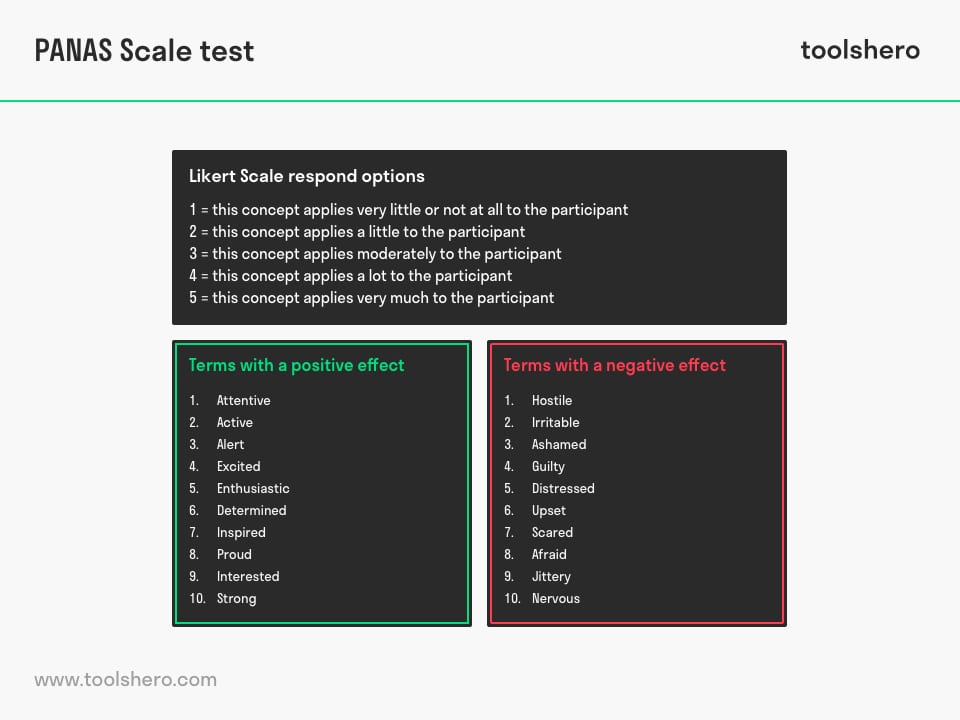PANAS Scale Test

PANAS Scale Test: this article explains the PANAS Scale test, developed by David Watson, Lee Anna Clark and Auke Tellegen in a practical way. Next to what it is, this article also highlights the Terms and items, it’s relation with the Likert Scale, the versions of the PANAS Scale and a downloadable and editable PANAS Scale Questionnaire. After reading it, you will understand the basics of this powerful Personal Happiness and motivation theory. Enjoy reading!
What is the PANAS Scale?
The PANAS Scale or Positive and Negative Affect Schedule (PANAS) is a self-report questionnaire. The list is split up into two segments, or mood scales. One scale measures a person’s positive emotion and the other scale measures the negative. Each segment has ten terms, which can be rated on a scale of 1 to 5 to indicate the extent to which the respondent agrees that this applies to him. The PANAS Scale was developed in 1988 by three American psychologists: David Watson, Lee Anna Clark and Auke Tellegen.
At that time, the PANAS Scale was mainly applied to measure changes in feeling and emotion when conducting research tasks. The test is also used as a research tool in group studies. It’s a psychometric scale that shows the relationship between positive and negative emotions with personality statistics and characteristics. When completing the questionnaire, the point is to determine how a person feels at that moment.
Nevertheless, the PANAS Scale is focused on self-reporting, which sometimes makes it difficult to accurately assess a person’s state of mind. Human beings are subjective and can underestimate or overestimate their own mood.
PANAS Scale Terms and items
The PANAS Scale has now become a standardised way of measuring changes in mood. The test comprises 20 terms, with ten focusing on a positive emotion and the other ten focusing on a negative emotion. Initially, the test comprised 60 terms, but after several testing and elimination rounds, 20 balanced concepts remained.
Terms with a positive affect
- Attentive
- Active
- Alert
- Excited
- Enthusiastic
- Determined
- Inspired
- Proud
- Interested
- Strong
Terms with a negative affect
- Hostile
- Irritable
- Ashamed
- Guilty
- Distressed
- Upset
- Scared
- Afraid
- Jittery
- Nervous

Figure 1 – an overview of the positive and negative items
Likert Scale
Participants in the PANAS Scale respond to all 20 terms according to the Likert scale. This implies the following options:
- this concept applies very little or not at all to the participant
- this concept applies a little to the participant
- this concept applies moderately to the participant
- this concept applies a lot to the participant
- this concept applies very much to the participant
The final score of the PANAS Scale / Positive and Negative Affect Schedule (PANAS) test is the sum of the 10 terms on the positive scale and the sum of the 10 terms on the negative scale. The value assigned is positive for answers on the positive scale and negative for answers on the negative scale.
PANAS Scale Versions
Several versions of the PANAS scale have been developed over the years and are intended for different target groups, including PANAS-C, PANAS-SF, I-PANAS-SF and PANAS-X.
For example, the C in PANAS-C stands for ‘children’; this test has been specially developed to make it easier to differentiate emotional expressions pertaining to anxiety and depression in children. It was created as a tool to better measure and determine the emotional moods of children.
PANAS-SF is a shorter and more concise version of the original PANAS test. I-PANAS-SF is the international version of the short-form PANAS-test, which allows all 10 concepts in each scale to be understood and interpreted in the same way by different nationalities, making it reliable and valid. In this test, all ambiguities and room for interpretation have be removed and replaced by words that have an unambiguous meaning. This has resulted in a reliable and efficient test that can be used at an international level.
In 1994, David Watson and Lee Anna Clark developed a more extensive version of their original PANAS test from 1988; the PANAS-X. Characteristic of this test is the fact that it can be completed in 10 minutes.
The PANAS-X test contains the original concepts, but these are now divided into three main categories. The first category contains basic negative emotions, consisting of fear, hostility, guilt, and sadness. The second category contains the basic positive emotions. This consists of joviality, self-assurance, and attentiveness.
The third and final category is that of other affective states consisting of shyness, fatigue, serenity, and surprise. Emotion is not always black or white and in this sense these three main categories provide insight into the fluctuating emotional states in which people can find themselves.
PANAS Scale Questionnaire
Start describing and measuring your feelings and emotions with this ready to use our PANAS Scale Questionnaire in Docx format.
Download the PANAS Scale Questionnaire
This template is exclusively for our paying Toolshero members. Click here to see if a membership is something for you!It’s Your Turn
What do you think? Have you ever heard of the PANAS Scale? Do you recognize the practical explanation or do you have more suggestions? What are your success factors for personal happiness and how do you get motivated?
Share your experience and knowledge in the comments box below.
More information
- Mackinnon, A., Jorm, A. F., Christensen, H., Korten, A. E., Jacomb, P. A., & Rodgers, B. (1999). A short form of the Positive and Negative Affect Schedule: Evaluation of factorial validity and invariance across demographic variables in a community sample. Personality and Individual differences, 27(3), 405-416.
- Watson, D., & Clark, L. A. (1999). The PANAS-X: Manual for the positive and negative affect schedule-expanded form.
- Watson, D., Clark, L. A., & Tellegen, A. (1988). Development and validation of brief measures of positive and negative affect: the PANAS scales. Journal of personality and social psychology, 54(6), 1063.
How to cite this article:
Mulder, P. (2018). PANAS Scale Test. Retrieved [insert date] from Toolshero: https://www.toolshero.com/psychology/panas-scale/
Original publication date: 05/25/2018 | Last update: 11/29/2023
Add a link to this page on your website:
<a href=”https://www.toolshero.com/psychology/panas-scale/”>Toolshero: PANAS Scale Test</a>












